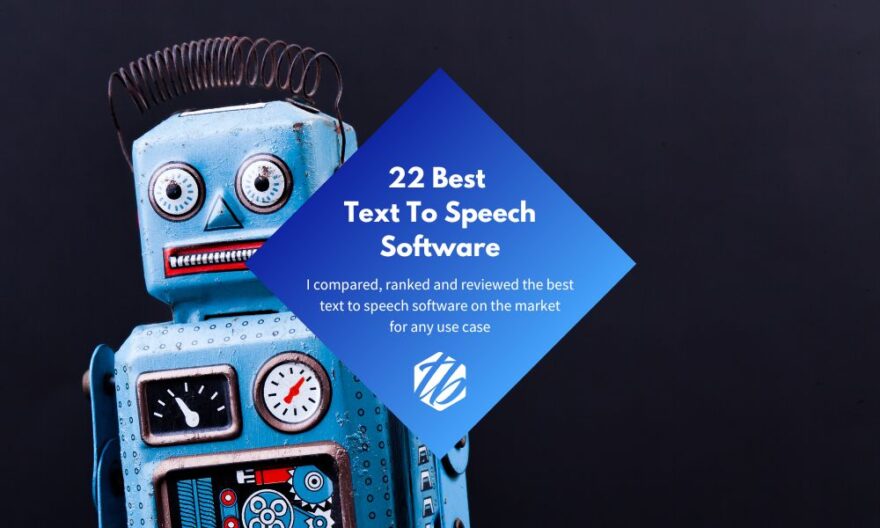Curios what the best text to speech software is in 2022? In this article I rank, review and compare the best text to speech software available on the market right now.
There are many reasons you might want to use text to speech software.
Maybe you’re an individual with visual or reading impairments, dyslexia or a learning disability. Or you’re a blogger who wants to turn blog posts into podcast episodes or YouTube videos. Or you’re a company that wants to easily and quickly turn any text into audio or video format.
Whatever the case may be, text to speech software is on the rise and has many different uses cases for individuals, bloggers, podcasters and companies.
There are plenty of choices when it comes to choosing the best text to speech software. I looked at 22 text to speech software tools and ranked them according to features, user experience, pricing and key benefits and downsides.
If you don’t want to read the entire article and skip ahead, my top three picks are Play.ht, Murf and Notevibes.
Disclosure: Some of the links in this article may be affiliate links, which can provide compensation to me at no cost to you if you decide to purchase a paid plan. These are products I’ve personally used and stand behind. This site is not intended to provide financial advice and is for entertainment only.
What Are the Best Text to Speech Software?
Here are my top pics for the best text to speech software:
- Play.ht
- Murf
- Notevibes
- Lovo
- Descript
- iSpring Suite
- Synthesys
- Speechelo
- NaturalReader
- WellSaid
- Wideo
- Google Text to Speech
- Amazon Polly
- iSpeech
- CereWaveAI
- ReadSpeaker
- Kukarella
- Resemble AI
- Capti Voice
- Microsoft Azure
- IBM Watson
- NextUp
1. Play.ht.
The best text to speech software overall.
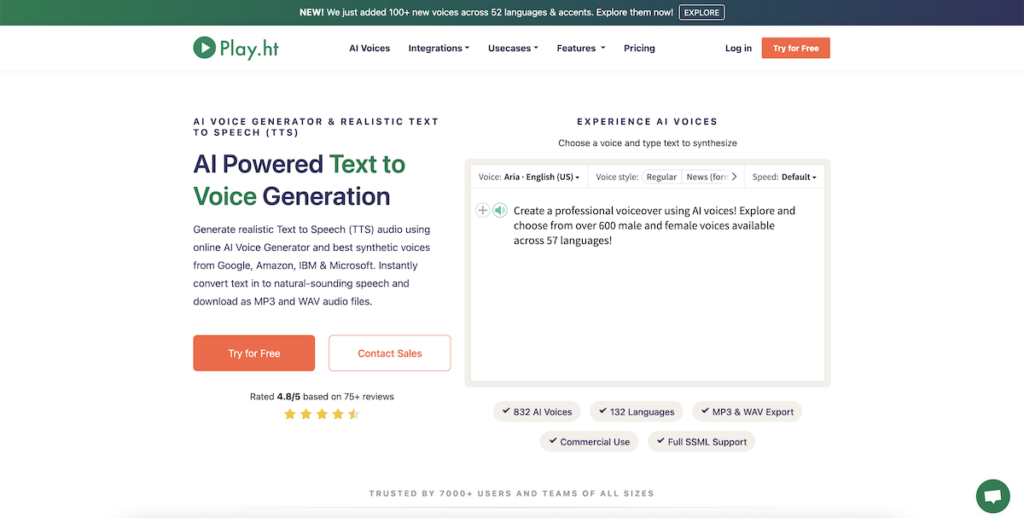
My #1 pick is Play.ht.
Play.ht is one of the best text to speech software tools available for several reasons. It comes with an astonishing number of voices and is available in more languages than most other tools.
The voices sound very natural and non-robotic.
Key Features:
What I love about Play.ht is that there are 832 voices to choose from. And Play.ht is available in 132 languages and accents. Most other tools that I’ve tried had significantly less voices and language options.
You can easily export files in MP3 or high-quality WAV format.
All exported files come with commercial rights, which means you can use it for broadcasting, YouTube monetization and other uses. There is no limit to how many voiceovers you can download per month unlike some other tools.
One of my favorite features is that Play.ht comes with a pronunciation and phonetics library that allows you to fine-tune your voices. You can fine tune how certain words are pronounced and then save them in your library.
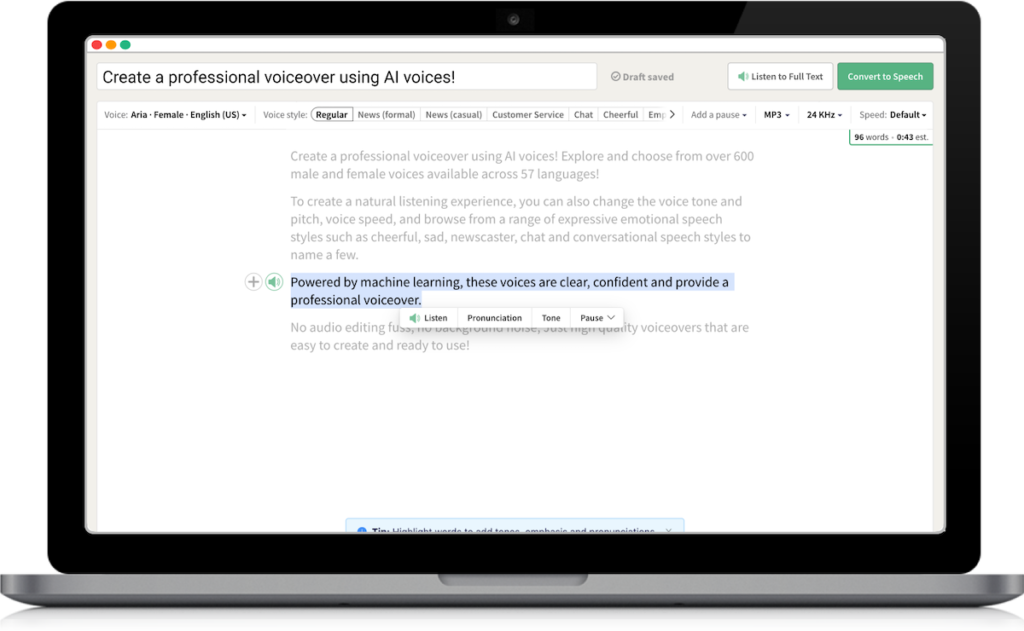
You can easily add natural pauses, change the speed and pitch of your voices.
Play.ht comes with podcast hosting and customizable players that allows bloggers, podcasters and content creators to easily stream your voiceovers on your website. This is especially beneficial if you’re planning to use Play.ht for a podcast or if you want to offer an audio version of your blog posts along with your articles.
Additional Features:
If you’re looking to offer text to speech services to others, Play.ht comes with the ability to re-brand and re-sell voiceovers to other businesses. Let’s say you’re a content creation agency for bloggers. How about selling a service to turn all blog posts into audios? You can charge a monthly fee for that and resell voiceovers under your own brand.
While you might not need all the features mentioned above, Play.ht is by far the most exciting text to speech software available on the market with extremely reasonable prices for what it does. There is also a voiceover API for developers to create custom integrations.
It’s my top pick and the text to speech software I recommend you use whether you’re an individual, blogger, podcast host or company.
Pricing:
Play.ht comes with a personal plan for $19 a month. You can convert up to 20,000 words. The downside of the person plan is that you cannot use the audios commercially and there are certain limitations to the number of voices that you can use.
The professional plan costs $39 a month and comes with up to 50,000 words and commercial rights. It even includes podcast hosting and customizable players you can use on your site.
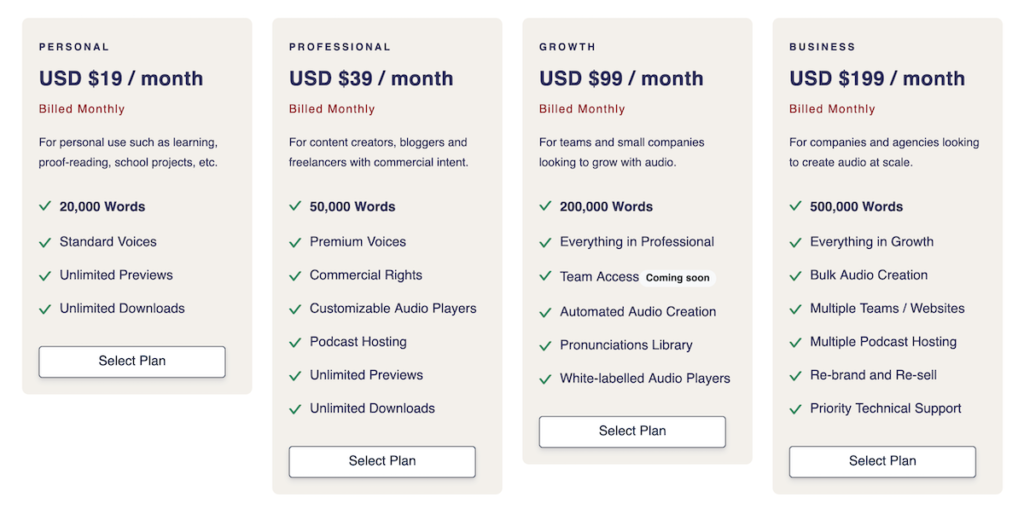
The growth plan costs $99 a month and comes with 200,000 words, everything that’s included in the professional plan and the pronunciations and phonetics library. The pronunciations and phonetics library make it worth it to choose the growth plan.
In case you want even more features, such as 500,000 words a month, bulk audio creation, priority support and the ability to re-brand and re-sell Play.ht, you can choose the business plan for $199 a month.
What I Like/Dislike About Play.ht:
Like:
- Huge selection of voices
- Available in lots of languages and accents
- Pronunciation and phonetics library for ultra-natural voices
- Unlimited downloads on all plans
- Includes podcast hosting
- Includes customizable players you can embed on your website
- Ability to re-brand and re-sell voiceovers
Dislike:
- Nothing major
Get started with play.ht.
2. Murf.
Great text to speech software.
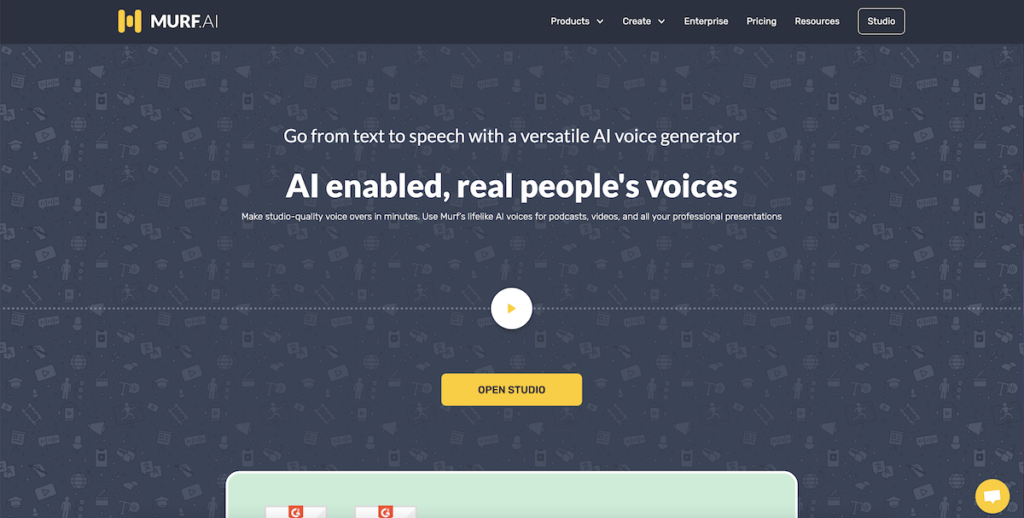
My second pick is Murf.
Murf is a text to speech software that comes with a simple tool to convert text into audio. You can easily change the speed, adjust the pitch and insert a pause to module your audio output. Voices are natural sounding and Murf is available in 20 languages which makes it one of my top picks.
Key Features:
Murf comes with a simple text to voice editor. All you have to do is paste your text into the editor, select your voice and Murf will generate a high-quality, natural sounding voiceover.
You have a wide selection of male and female voices.
Although the voices built-into Murf already sound very natural and non-robotic, you can make your voices sound even more natural by emphasizing certain words, speeding up the audio, adjusting the pitch or adding pauses.
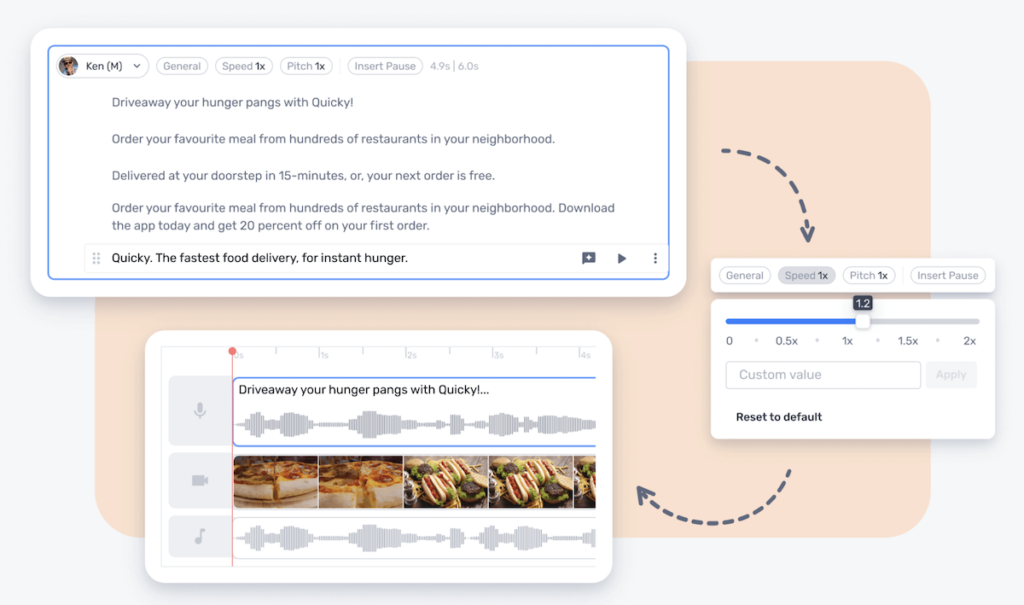
Whenever an AI voice sounds robotic, it’s usually because the voice lacks the nuances of a human speaker. If a sentence ends and the next one begins too quickly, or if the pitch of the voice doesn’t fluctuate slightly when speaking, this can make the audio dull and mechanic.
By adjusting these elements, you can make your voiceover sound even more natural.
Pricing:
Murf offers a free plan with up to 10 minutes of voice generation. The paid plans start at $19 a month for 2 hours of voice generation and access to 60 voices.
The pro plan costs $39 a month and comes with 8 hours of voice generation a month and access to 120 voices.
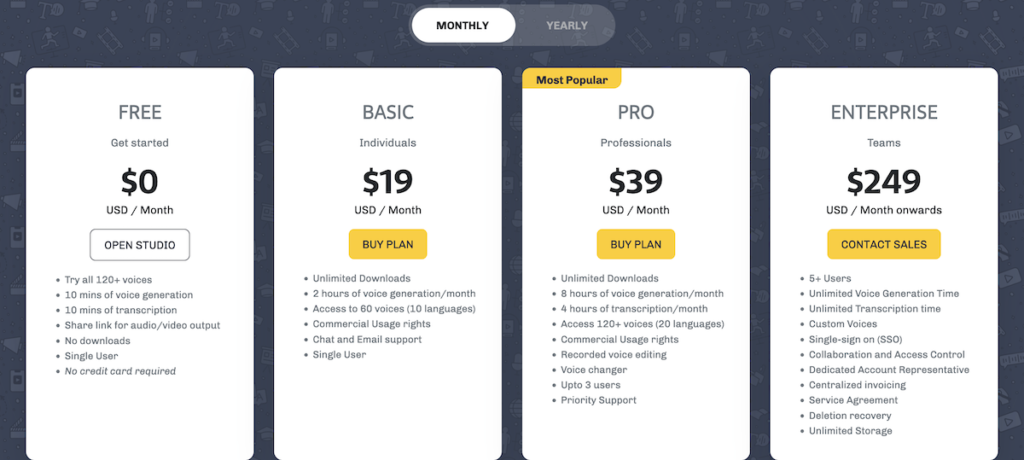
Finally, if you want to create a custom AI voice for your business, you can schedule a call with the team and Murf. The enterprise plan gives you unlimited voice generation time, custom voices and other features that allow you to use Murf as a full text to speech software for your company.
What I Like/Dislike Murf:
Like:
- Free plan
- Natural sounding voices
- 20 languages
- They can build custom AI voices for you
- Easy editor
- Add pauses, change the pitch and emphasize words easily
Dislike:
- There’s limits to what you can do on the free and basic plan
Get started with Murf.
3. Notevibes.
Best text to speech software with lots of voices.
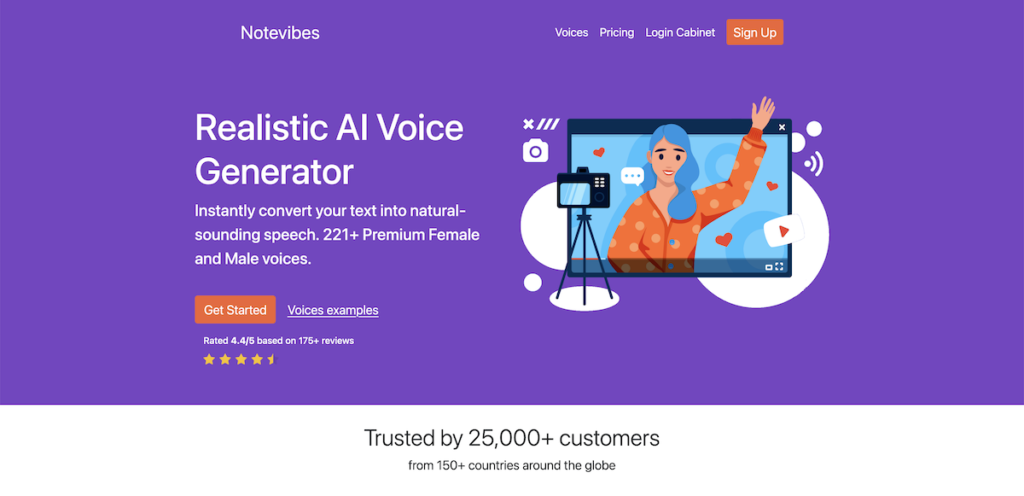
Notevibes is a great text to speech software if you’re looking for even more variety in voices and more languages. Notevibes comes with 201 natural sounding voices and is available in 26 languages.
Key Features:
Notevibes comes with an advanced editor that allows you to add different levels of emphasis on certain words. You can emphasize certain words strong, moderate or reduced.
Notevibes allows you to easily adjust the volume, speed and pitch of your voiceover.
You can also add pauses ranging from 0.5 seconds to 4 seconds and automatically insert pauses after full stops and commas.
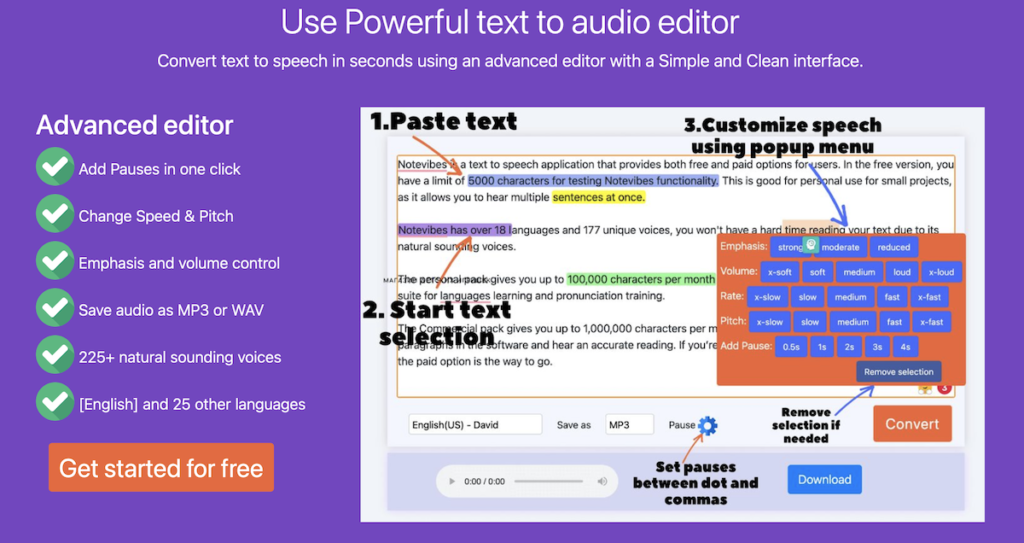
Using Notevibes is a simple as pasting your text, choosing your voice, highlighting text parts you want to customize by changing the emphasize, volume, speed or pitch and then downloading your finished audio file as an MP3 file or in another audio format.
Pricing:
Notevibes starts at $19 a month for personal use. With the “Personal Pack” you have access to all 201 voices but you can only use the files for personal use and up to 100,000 characters a month.
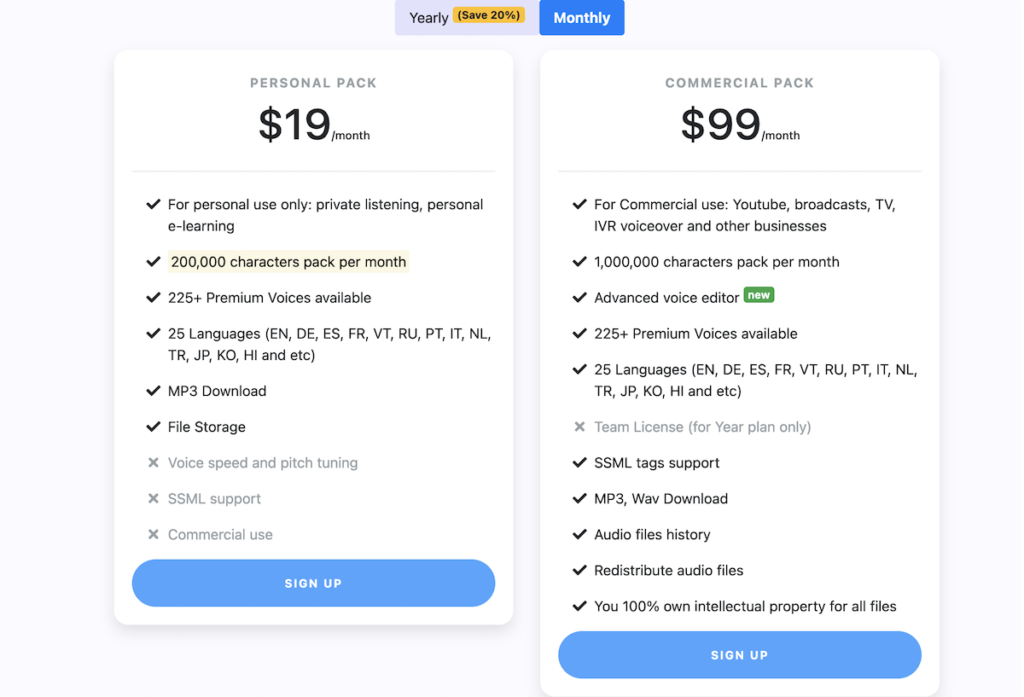
If you want to use the voiceover for YouTube, broadcasts, TV, IVR voiceovers and other business related activities, you have to get the “Commercial Pack” for $99 a month. The commercial plan comes with 1,000,000 characters per month and the availability to download your audio in higher quality WAV format.
What I Like/Dislike About Freedom
Like:
- Lots of voices
- Wide selection of languages
- Easy to use text to voice editor
- Simple and straight forward
Dislike:
- No free plan
Get started with Notevibes.
4. Lovo.
Next-generation AI voiceover and text to speech software.
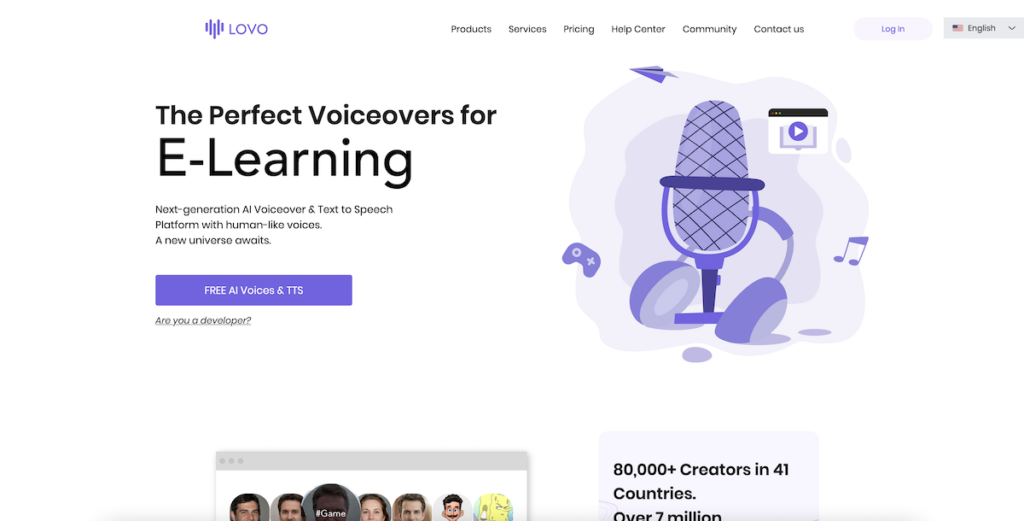
Lovo is an incredibly powerful text to speech software that allows you to create custom voices based on your own voice. Apart from that, it comes with 180 natural sounding voices and is available in 33 languages.
Key Features:
The two features that make Lovo stand out most are the ability to create custom AI voices using just 15 minutes of your voice. This means you can literally “clone” your voice. Feed Lovo 15 minutes of your desired voice and it will create a custom voice.
The next time you need a natural sounding voiceover, just use your own custom voice.
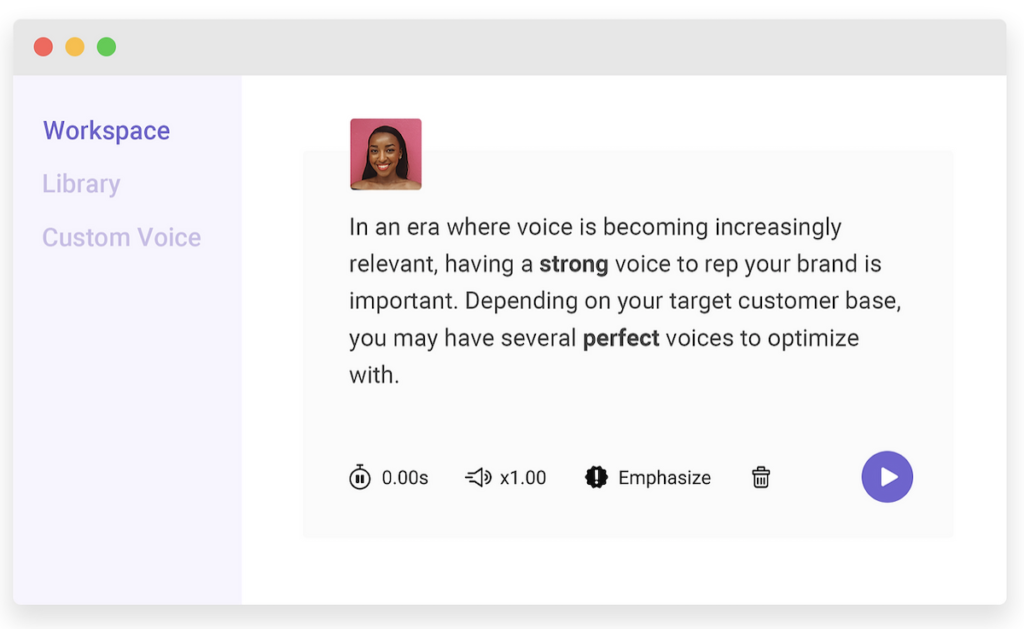
This is great if you want to create voiceovers using your own voice instead of a pre-built voice. It’s also a powerful option for brands that want to maintain an authentic and unique brand voice.
The second feature that stands out is that Lovo is built for developers. Lovo has a Voiceover API that allows you to use this text to speech software in your own apps and on your website in creative ways.
Pricing:
Lovo has a free plan which gives you access to their premium voices for 3 days. However, you can’t use any voiceovers created using the free plan for commercial purposes like advertising and you have to credit Lovo.
The personal plan costs $34.99 a month and allows you to add background music. You can convert up to 15,000 characters per download and you get commercial rights with your audio files. You are limited to 30 downloads a month though and have to credit Lovo if you use it for YouTube monetization.
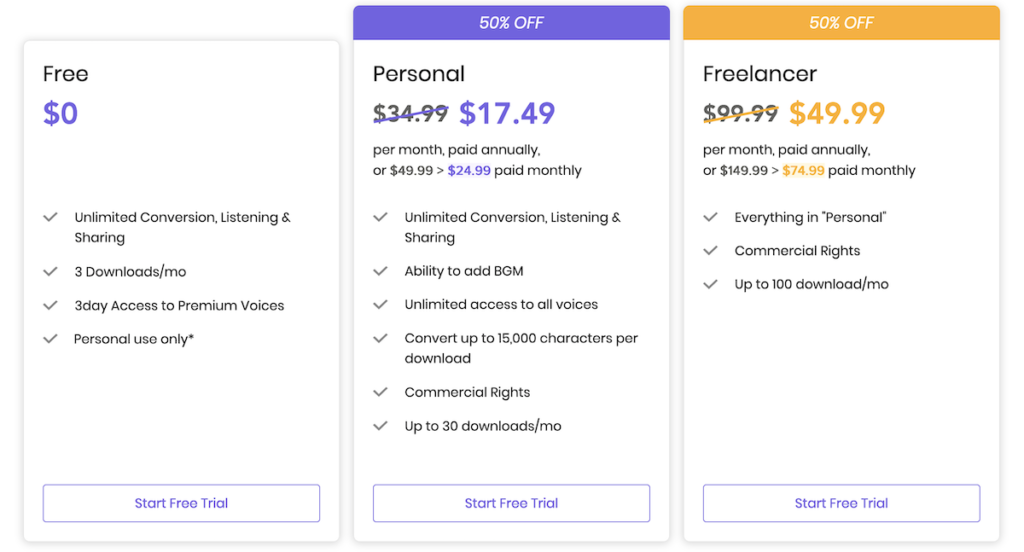
The “Freelancer” plan costs $99.99 and includes 100 downloads a month and commercial rights without the need to credit Lovo when using it for YouTube monetization.
The voiceover API is subject to additional usage costs.
What I Like/Dislike Lovo
Like:
- Natural
- DIY voice cloning
- Create custom voices
- Voiceover API for developers
Dislike:
- Limited to 100 downloads a month
Get started with Lovo.
5. Descript.
All-in-one video audio editing and text to speech software.
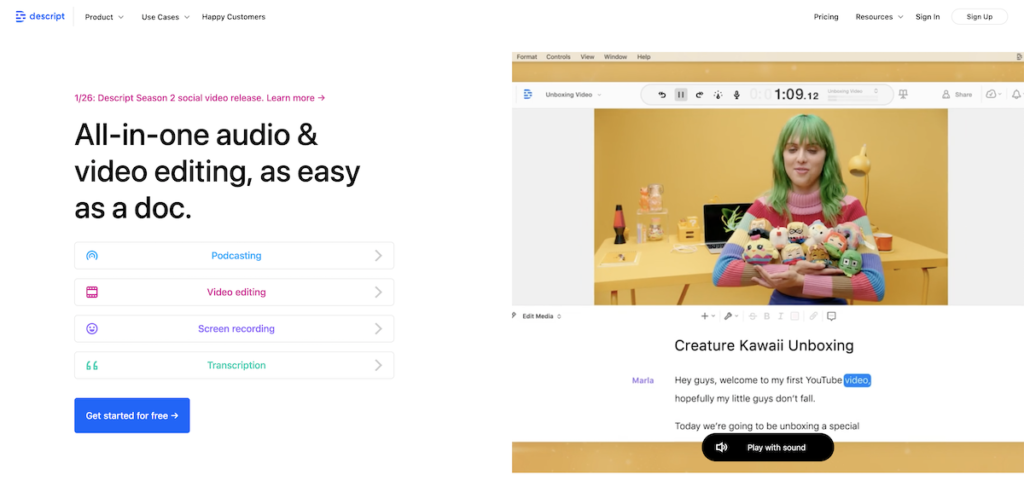
Descript is another versatile tool that allows you to do all sorts of different things. I’ve used Descript several times in the past and although my favorite text to speech software is Play.ht, you should definitely look into Descript if you want more of an all-in-one tool for audio and video editing.
Key Features:
With Descript you can create transcripts, edit videos and podcasts and even record your screen. It’s more than just a text to speech software. You can think of it more like a complete content publishing suite.
There aren’t that many voices to select from but the voices that are available sound very natural and human-like.
Descript’s text to speech feature is called Overdub.
You can also create your own custom voice skin based on your voice. This is a powerful feature if you want to “clone” your voice or create a custom and unique brand voice for your business.
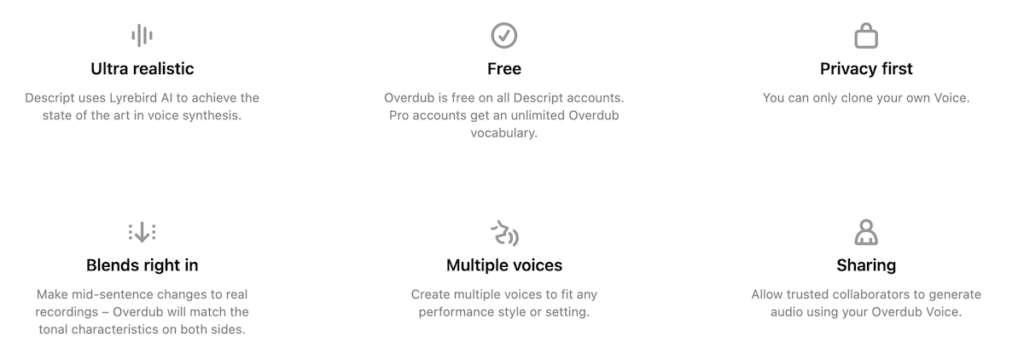
Other features include automatic removal of filler words in transcripts, such as “uhhh” and “uhhhm”. You can create visualizations of your audio, add text, subtitles, images and video on top of your audio all in one powerful audio and video editor.
Another cool feature is that you can record your podcast episode directly from Zoom, Skype and other popular conferencing tools into Descript. No need to download and import the recording manually.
Hook up the tools and your podcast recording appears automatically in Descript, ready to be transcribed or turned into an engaging social media clip or YouTube video.
Pricing:
Descript has a free plan that allows you up to 3 hours of transcripts. Exported videos will include a Descript watermark though.
The creator plan costs $15 a month and comes with 10 hours of transcripts.
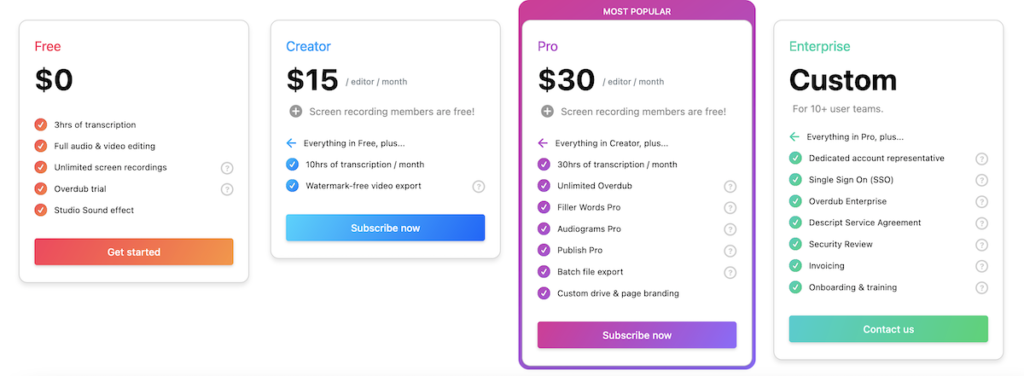
To unlock all features, you can upgrade to the pro plan for $30 a month. This plan includes up to 30 hours of transcripts per month.
What I Like/Dislike About Descript:
Like:
- Free plan
- All-in-one tool for podcasters
- Audio vizualizations
- Full audio and video editor
- Screen recording feature
- Natural sounding voices
- Custom voice creation
Dislike:
- Smaller voice selection
- Possibly more features than you need
Get started with Descript.
6. iSpring Suite.
E-learning course creation software with text to speech functionality.
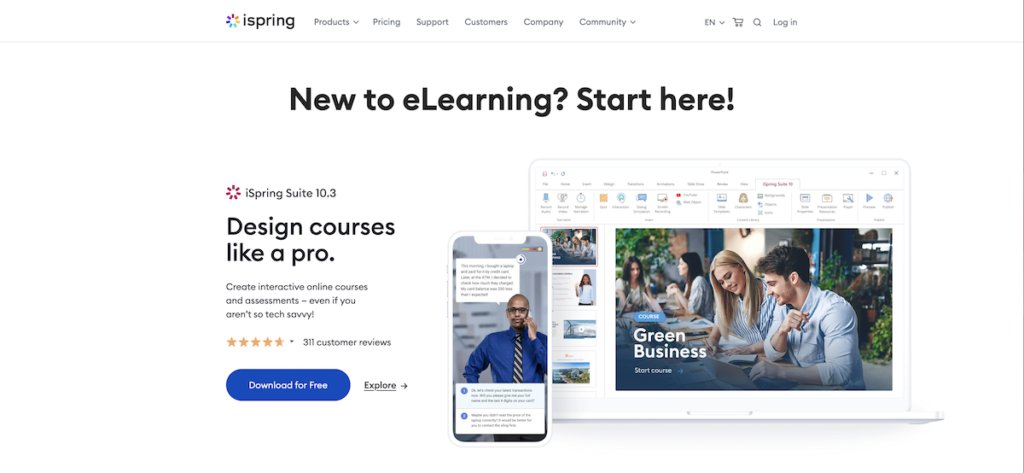
iSpring isn’t just a text to speech software.
It’s a full e-learning course creation tool that allows you to turn PowerPoint like presentations into online courses. However, iSpring comes with built-in text to speech functionality and supports up to 42 languages.
Key Features:
If you’re looking to turn PowerPoint presentations and PDFs into engaging online courses to train your team or teach something online, iSpring is what you’re looking for. Instead of just training your team with a manual, why not turn texts into videos, engaging questionnaires and quizzes?
With the built-in text to speech functionality you can easily turn written text in PowerPoint presentations and PDFs into engaging audios and videos.
Similar to Descript, you can also record your screen, edit audios and videos and turn them into engaging content.
Pricing:
iSpring Suite only offers yearly plans.
The basic plan, iSpring Suite, costs €690 a year.
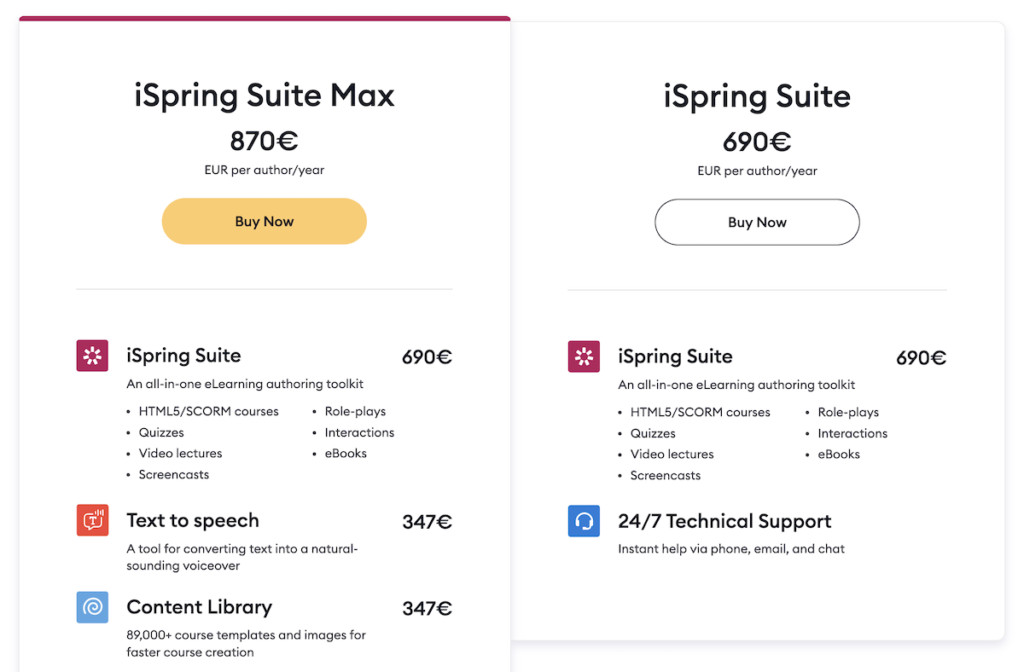
For academic and non-profit usage you can get a discounted license for €420 a year.
What I Like/Dislike About iSpring:
Like:
- Great for online course creation
- Excellent way to turn PowerPoint presentations and PDFs into audio or videos
- Screen recording
Dislike:
- Doesn’t specialize just in text to speech software
- Only offers annual plans
Get started with iSpring Suite.
7. Synthesys.
AI voice generator and text to speech software.
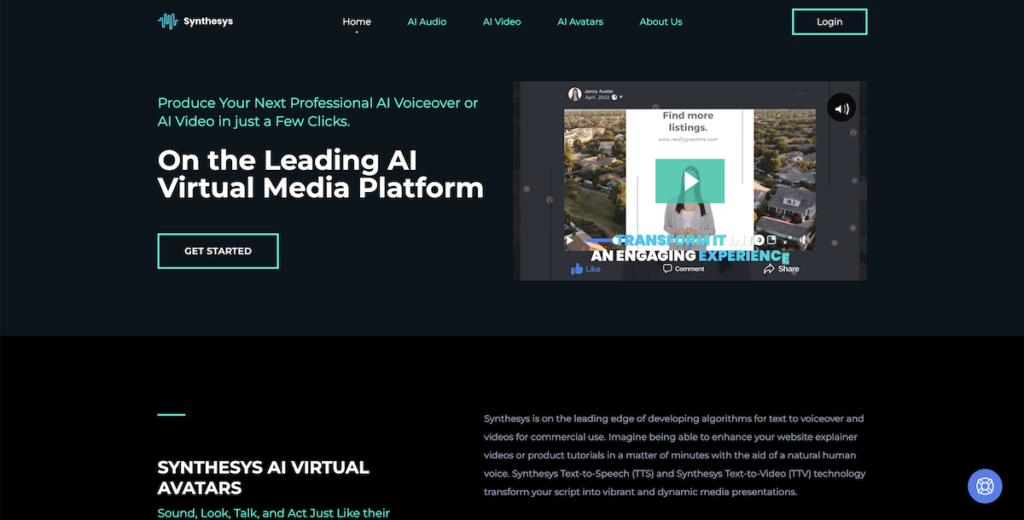
Synthesys is a simple text to speech software that allows you to turn text into audio. Creating a voiceover is as simple as choosing your voice, entering your text and clicking “create”.
Key Features:
One of the features that stands out is that Synthesys also allows you to create AI videos. You can choose from a selection of voices to turn text into speech, but how about having an AI spokesperson in the corner of your video narrating your text? This is a unique feature that Synthesys offers.
If you’re looking for an automated spokesperson for your videos, Synthesys is a great option. Gone are the days that you need to pay a voiceover artist or spokesperson on Fiverr or Upwork.
Just convert your text into speech and then have one of Synthesys’ AI spokespersons narrate your video.
Synthesis also allows you to create a custom avatar or spokesperson for your videos and clone your voice. This is pretty cool if you’re looking for an AI spokesperson. Although it could be a bit creepy to see a robotic version of yourself narrate a video with your own cloned voice.
But maybe that’s exactly what you need?
Pricing:
Paid plans start at $29 a month.
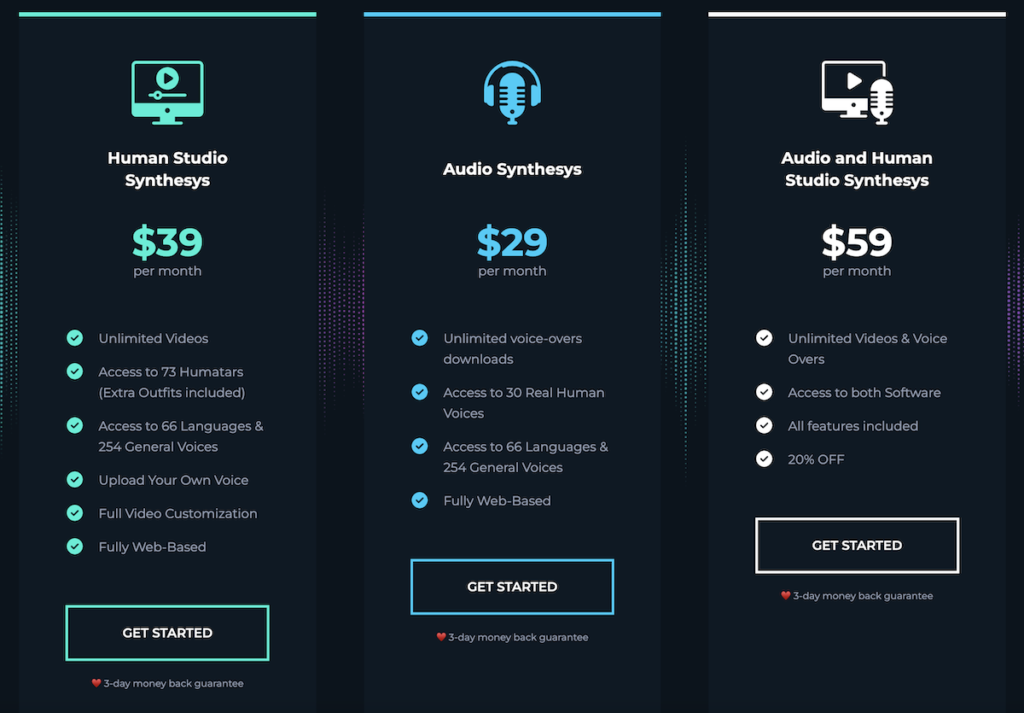
To unlock additional features such as the ability to upload your own voice and create spokesperson videos, you’ll need the $39 a month or $59 a month plan.
What I Like/Dislike About Synthesis:
Like:
- Turn voiceovers into spokesperson videos
- Create your own avatar
- Clone your voice
Dislike:
- Voices sound a bit more robotic than some other text to speech software
8. Speechelo.
Low-cost text to speech software.
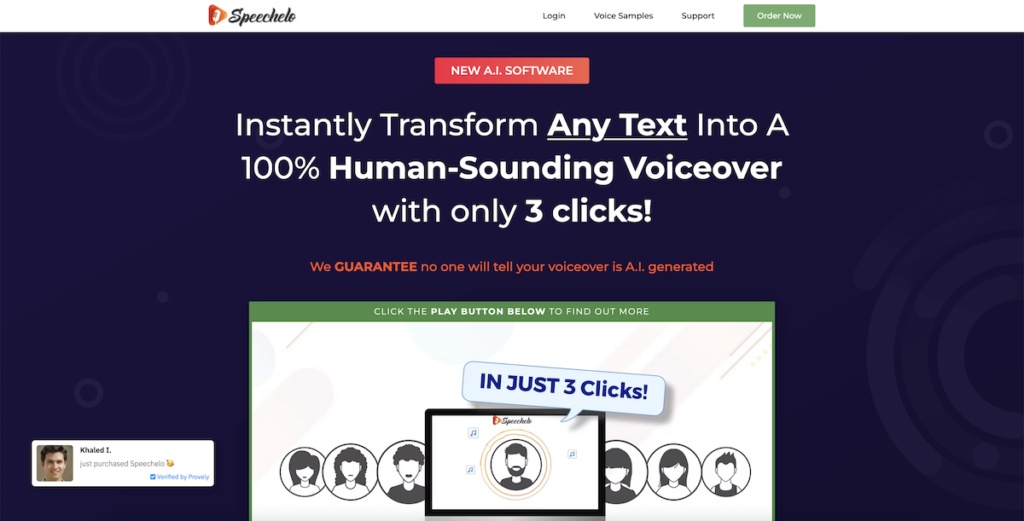
Speechelo is a very affordable text to speech software since it comes with a one-time payment and no monthly fees. This is why I decided to include it in this list. It might be the cheapest text to speech software available, but I’ve read a few negative reviews about the software.
If you’re looking for cheap, Speechelo is great. But if you’re looking for quality, it might be worth paying a bit more.
Key Features:
Speechelo comes with 30 voices and is available in 24 languages.
You can read text in three tones, either normal, joyful or serious. Speechelo comes with both male and female voices and claims to be the only text to speech software that adds inflections in the voices.
Speechelo says on their website that 98% of people hearing a voice generated with Speechelo can’t tell it’s not a human voice. If this is true, it’s impressive. Their demos and voice examples sound good indeed.
However, I read in a review someone posted online that the voices included in the software don’t sound as good as the demos on the website and that some misleading marketing might be going on.
Regardless of this, Speechelo is one of the few tools I’ve found that offers a one-time payment option. This means, you pay once and you get lifetime access to the software and voices for less than $100.
Pricing:
One-time payment of $47.
What I Like/Dislike About Speechelo:
Like:
- Cheap
Dislike:
- Saw some negative reviews
- Not as many voices and features as other text to speech software
Get started with Speechelo.
9. NaturalReader.
Great text to speech software for personal use.
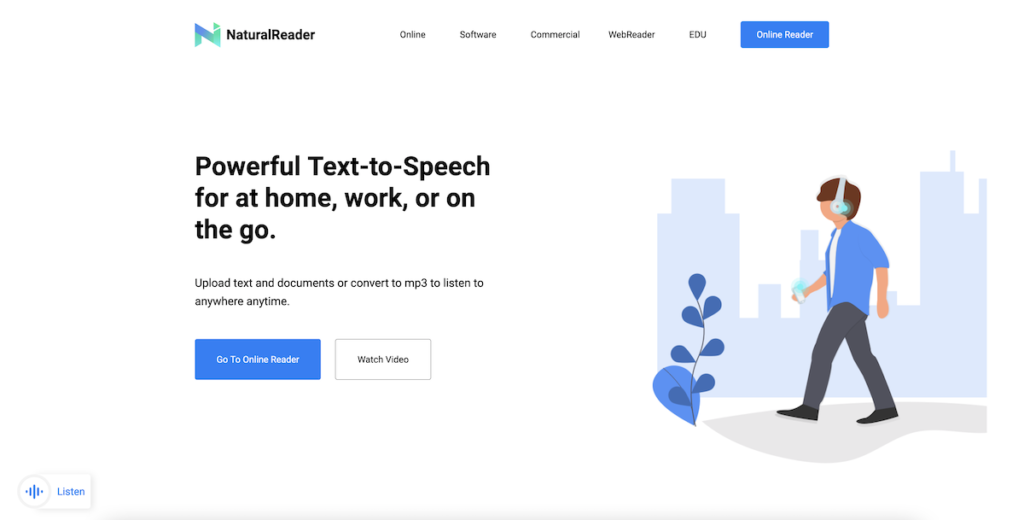
NaturalReader is mostly geared towards individual use for students, working professionals, dyslexic readers and foreign language learners. With NaturalReader you can turn texts into MP3s and listen to them anywhere on the go.
Key Features:
One of the cool things about NaturalReader is that it can turn many different types of documents into text. This includes Microsoft word files, webpages, PDFs and emails.
This makes it especially powerful for users with reading disabilities.
If your main reason for using text to speech software is some sort of reading disability, such as dyslexia, you should probably check out NaturalReader.
The text to speech engine of NaturalReader can also be used for commercial purposes such as YouTube videos, ads, e-learning and games. NaturalReader comes with 178 voices and 27 different languages.
One important thing to note is that NaturalReader is an actual software that you download and install on your Mac or Windows computer. It’s not entirely cloud-based.
Pricing:
NaturalReader comes with a free plan.
The paid licenses range between $99.50-$199.50 but these are one-time payments and not monthly subscriptions.

If you’d like to use NaturalReader for commercial purposes, you need to purchase a monthly subscription for $99 a month. There are annual plans as well where you get up to 50% off.
What I Like/Dislike About NaturalReader:
Like:
- Great for personal use
- One-time payment for personal use
- Read webpages, documents, websites and emails
Dislike:
- Requires the download and installation of software
Get started with NaturalReader.
10. WellSaid.
Best text to speech software for teams.
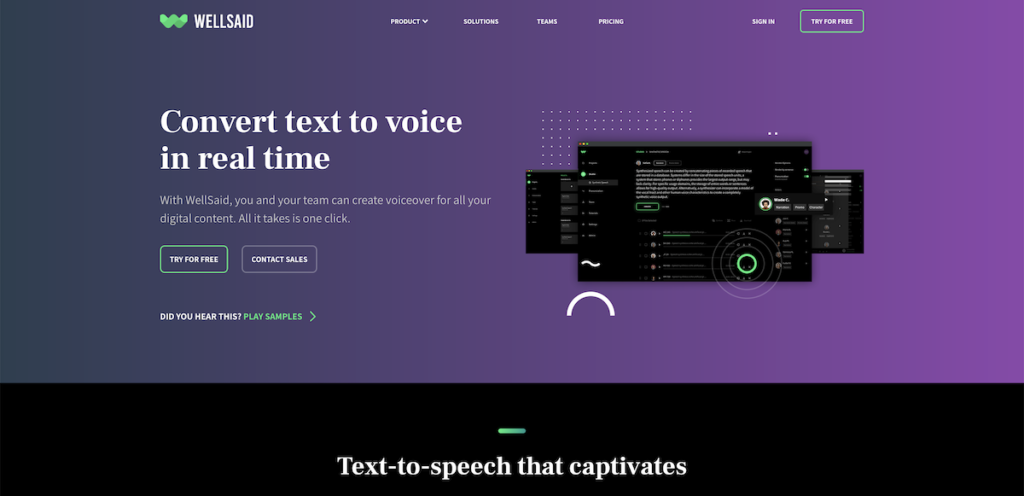
WellSaid is another text to speech software with realistic and human-sounding voices. It comes with several advanced features such as a phonetic library, API for developers and team collaboration.
Key Features:
WellSaid is probably the best text to speech software for teams.
It has certain features that make it very suitable as a collaboration tool for teams. With WellSaid, you can give your team access to the same projects so everyone is on the same page.
Another thing I like about WellSaid is that their voices sound pretty natural.
It’s hard to tell that voices were generated using artificial intelligence when listening to some of the demos and examples on the website. Another cool feature is that WellSaid comes with an API, which allows developers to create custom voiceover solutions and integrate them in apps and websites.
You can also create your own custom voice, or “clone” your voice.
Pricing:
WellSaid offers a free 1-week trial.
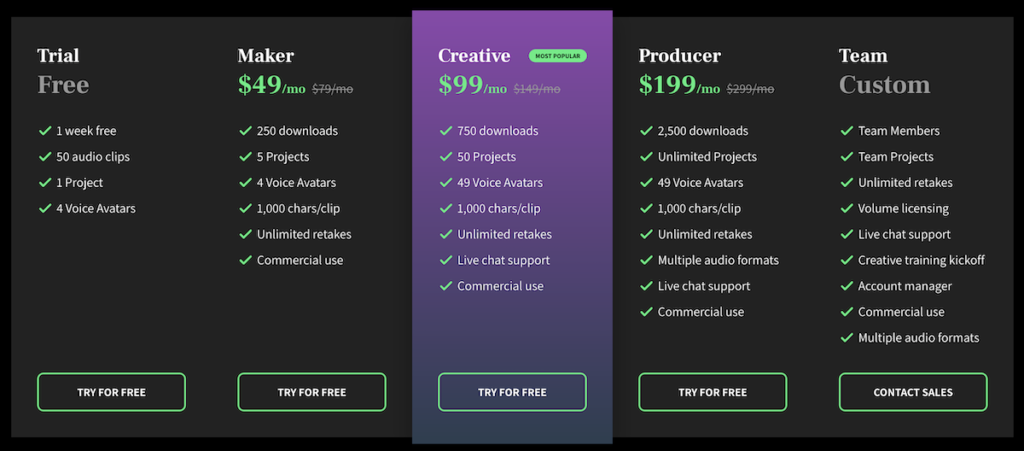
The paid plans start at $49 a month but for more features you’ll likely need the Creative or Producer plan which cost $99 a month or $199 a month respectively.
What I Like/Dislike About WellSaid:
Like:
- Great for teams
- Professional custom voice creation
Dislike:
- Quite a few limitations on characters and downloads
Get started with WellSaid.
11. Wideo.
Animated video creation and text to speech software.
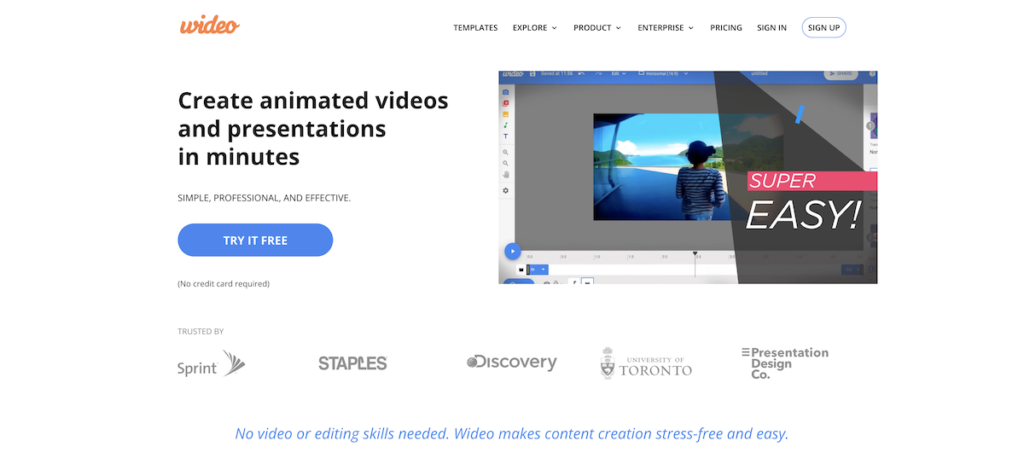
Wideo is more than just a text to speech software.
With Wideo you can create animated videos and presentations. It’s great for explainer videos and video sales letters. However, Wideo comes with text to speech functionality.
Key Features:
Wideo is an online video maker first and a text to speech software second.
The voices sound a bit more robotic than some of the other text to speech tools reviewed in this article. Nevertheless, if you’re also looking for a way to create animated and engaging videos and presentations, maybe having an all-in-one tool like Wideo is exactly what you need.
Pricing:
Wideo comes with a limited free plan.
It includes Wideo branding though and videos are limited to 1 minute.

Paid plans start at $59 a month and go all the way to $199 a month for longer videos.
What I Like/Dislike About Wideo:
Like:
- Great for animated videos
- Built in text to speech functionality
Dislike:
- Voices sound a bit robotic
Get started with Wideo.
12. Google Cloud Text To Speech.
Cutting-edge AI voice generator and text to speech engine.
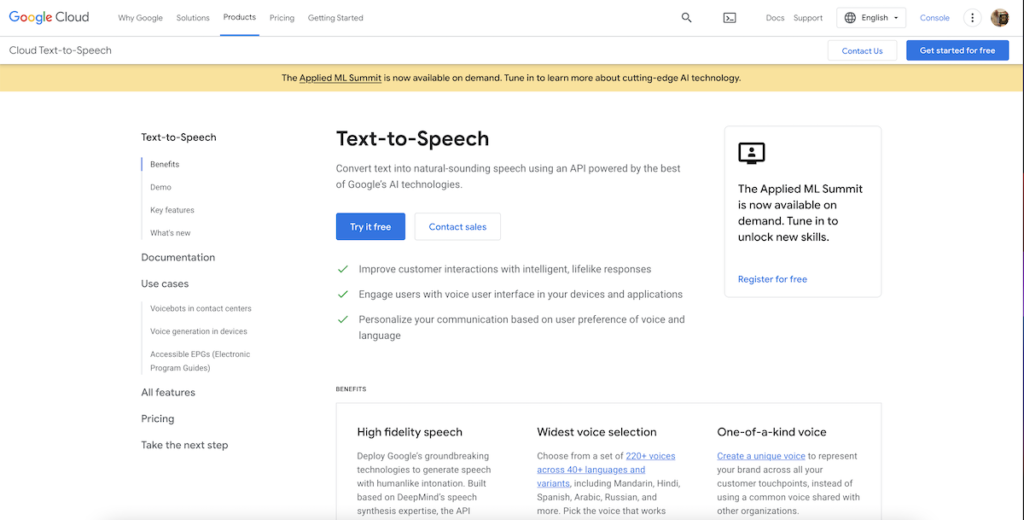
Google needs no introduction.
They are at the forefront of artificial intelligence so you better believe they have a great text to speech software. Google translate is another example of how powerful Google’s AI engines are.
Key Features:
Generate speech with humanlike intonation.
Google Cloud’s text to speech engine is driven by DeepMind’s speech synthesis expertise. What this means is that their text to speech function is driven by some of the most modern and groundbreaking artificial intelligence.
You can use the tool to create a unique voice to represent your brand.
Google’s text to speech tool comes with 220 voices and over 40 languages and variants.
It’s probably best suited for large corporations or developers who want to use the API to create custom app and website integrations. I don’t necessarily recommend it for smaller businesses, personal use or bloggers and podcasters.
Pricing:
Pricing is based on the number of characters you send to the service each month. There is some free usage included but then you’ll be charged $0.000004 USD to $0.000016 USD per character.
What I Like/Dislike About Google:
Like:
- Cutting-edge artificial intelligence
- Huge and reputable company with track record
- Great for scalability
Dislike:
- Not so user-friendly
- Requires more technical skills
Get started with Google Cloud Text to Speech.
13. Amazon Polly.
Amazon’s text to speech generator.
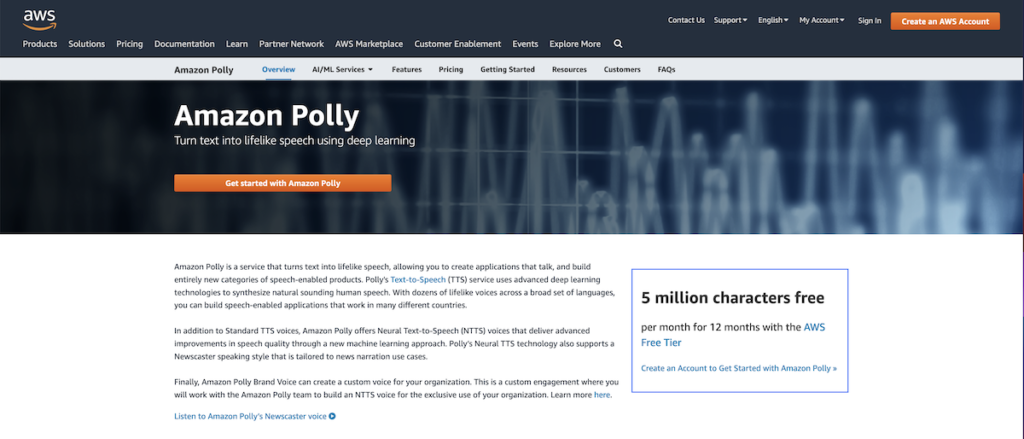
Amazon is another huge player that is tackling the text to speech industry.
Just like Google, they’re known for having some of the best AI algorithms available. This means, you’ll get cutting-edge technology and a great text to speech engine when using Amazon Polly.
Key Features:
Amazon Polly is best to create applications that talk.
You can build speech-enables products and use advanced deep learning technologies to turn text into audio. Through the advanced machine learning technology, voices sound natural and human-like.
Similar to Google’s tool, Amazon Polly is probably best suited for large enterprises that need scalable text to speech solutions.
Pricing:
You pay $4 per 1 million characters or $16 per 1 million characters using Amazon Polly’s Neural voices.
What I Like/Dislike About Amazon Polly:
Like:
- Cutting-edge artificial intelligence
- Huge and reputable company with track record
- Great for scalability
Dislike:
- Not so user-friendly
- Requires more technical skills
Get started with Amazon Polly.
14. iSpeech.
Robotic text to speech software.
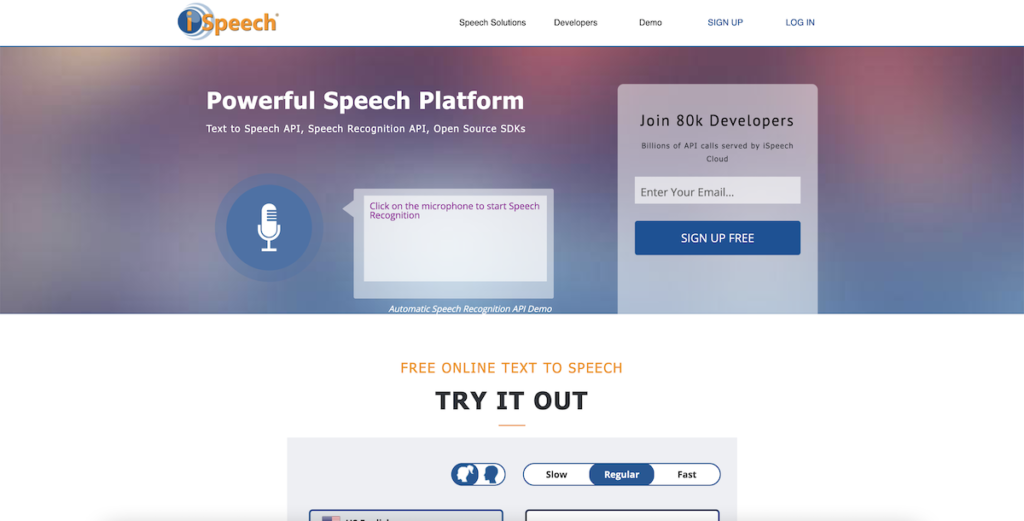
iSpeech is a text to speech software that has more robotic sounding voices.
This isn’t necessarily a bad thing. Want to crate an “Anonymous” sounding voice for a hacker video or game? Maybe you don’t want an overly human sounding voice but rather a classic robotic and mechanic sounding voice.
Key Features:
Jokes aside, although iSpeech sounds a bit more robotic than some of the other voices, it’s a great tool for developers. You can create voice-enabled mobile apps.
The text to speech engine is open-source.
There’s a cool Chrome app that allows you to read websites out loud. And there’s a powerful API which makes iSpeech a great text to speech software for certain use cases.
Pricing:
Free
What I Like/Dislike About iSpeech
Like:
- Free
- Great for developers
Dislike:
- A bit robotic sounding unless that’s what you want
Get started with iSpeech.
15. CereWave AI.
Another robotic text to speech software.
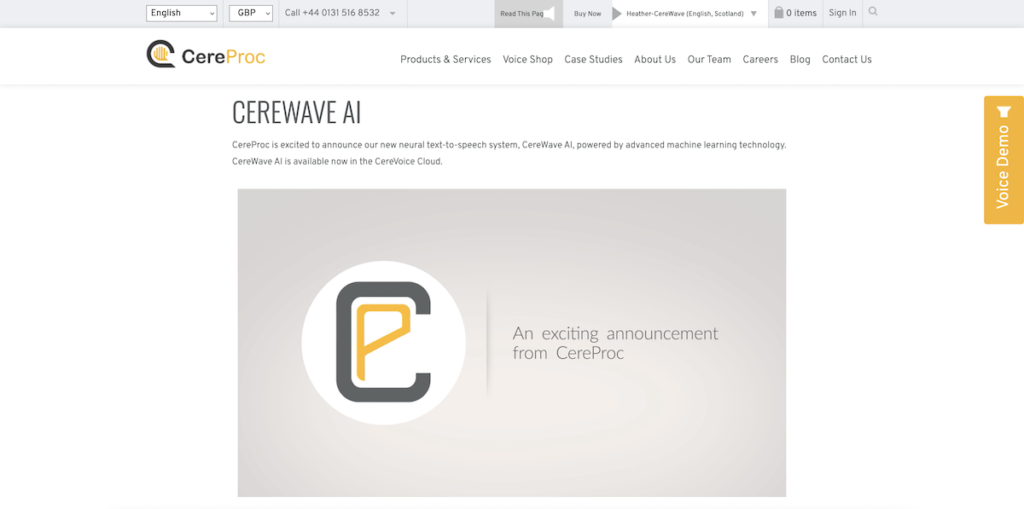
CereWave offers another old school text to speech software with more robotic and mechanical sounding voices. Great to re-create the famous “Anonymous” hacker group voice.
Key Features:
CereWave AI can be used for voice cloning as well as other things.
It does a lot of what other text to speech apps do but with slightly less natural sounding voices. Again, this doesn’t have to be a bad thing. If you’re specifically looking for a robotic sounding voice for a video game or YouTube videos, this could be a perfect fit for that.
CereProc also offers a developer program and many other things that could be interesting for developers and companies.
Pricing:
Couldn’t find any information on the website.
After some Googling it appears that the personal software sells for £25.99 and commercial use for £299.99.
What I Like/Dislike About CereWave AI:
Like:
- Robotic voices if it’s what you want
Dislike:
- Seems a bit old and outdated
- Couldn’t find pricing on the website
Get started with CereWave AI.
16. ReadSpeaker.
Slightly less robotic text to speech software.
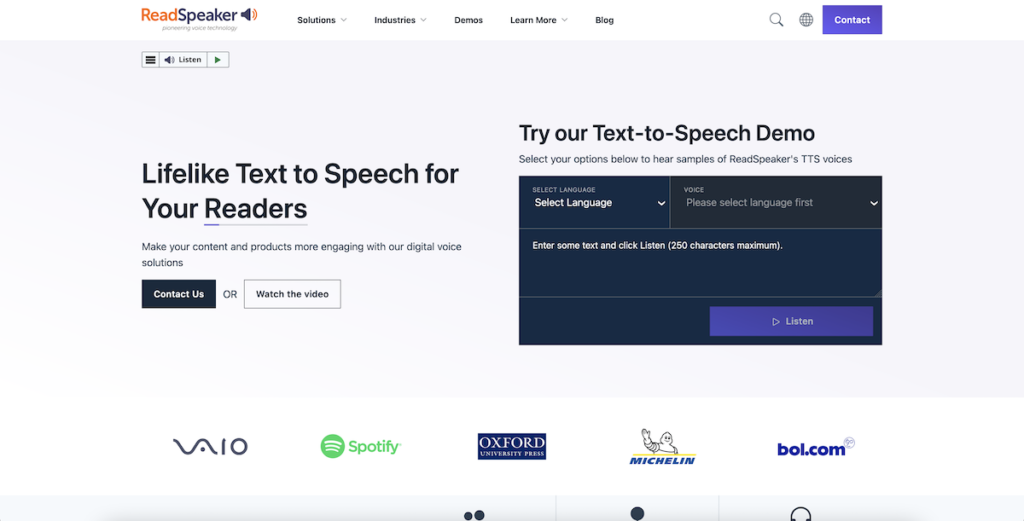
ReadSpeaker is another text to speech tool that has a bit more old school sounding voices.
The voices don’t sound as robotic as CereWave AI and iSpeech though. So if you’re looking for something in between very natural sounding and very robotic, ReadSpeaker fits that criteria in my opinion.
Key Features:
ReadSpeaker offers a web reader which allows you to turn websites into speech. This is really handy for anyone who has some sort of reading disability. They also have a document and form reader which makes ReadSpeaker an attractive text to speech software for personal use.
ReadSpeaker has an API which allows for custom integrations.
They offer ReadSpeaker TextAid, a tool for learning disabilities and literacy support.
Apart from reading out a website loud, you can use ReadSpeaker to highlight elements on a website while reading.
Pricing:
ReadSpeaker Text aid costs $4.90 a month.
However, pricing for their other products and commercial solutions couldn’t be found on their website and requires getting in touch or scheduling a meeting.
What I Like/Dislike About ReaderSpeaker
Like:
- Great TextAid tool
- Perfect for learning and reading disabilities
Dislike:
- Slightly robotic sounding
- Couldn’t find pricing for most products
Get started with ReadSpeaker.
17. Kukurella.
Simple online text to speech editor.
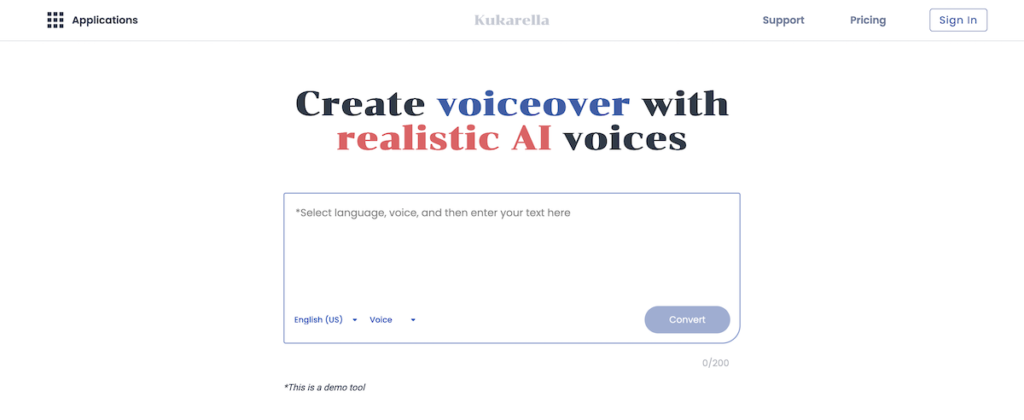
Kukurella uses artificial intelligence engines from Google, Amazon, Microsoft and IBM to deliver a simple text to speech online editor. Simply put, Kukurella makes the text to speech software provided by the four largest cloud companies more user-friendly and accessible.
Key Features:
User-friendly way to use Google, Amazon, Microsoft and IBM’s text to speech engines.
You don’t need to have technical skills or be a developer anymore. Kukurella bridges the gap between the end user and these tools. They provide a simple and beautiful interface to convert text into audio.
All generated files can be used for commercial purposes, except when using the free plan.
Pricing:
Kukurella offers a free plan that includes up to 3,000 characters a month.
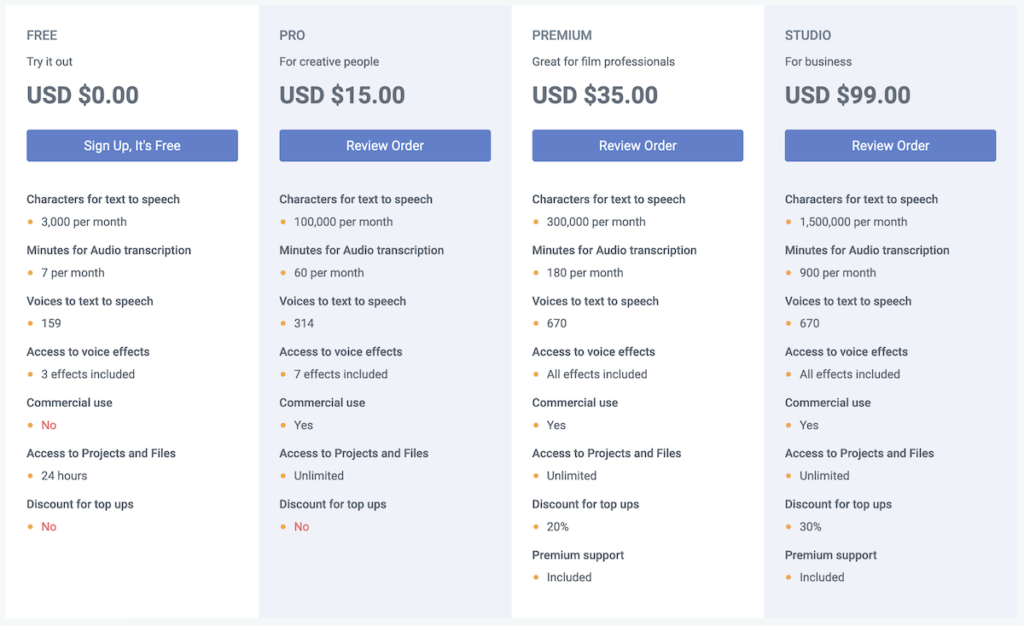
Pro plans start at $15 a month all the way to $99 a month. The paid plans include more characters and available voices.
What I Like/Dislike About Kukurella:
Like:
- Free plan
- Intuitive and user-friendly
- Based on the best available AI technology
Dislike:
- Limited features
Get started with Kukurella.
18. Resemble AI.
Great text to speech editor to clone your voice.
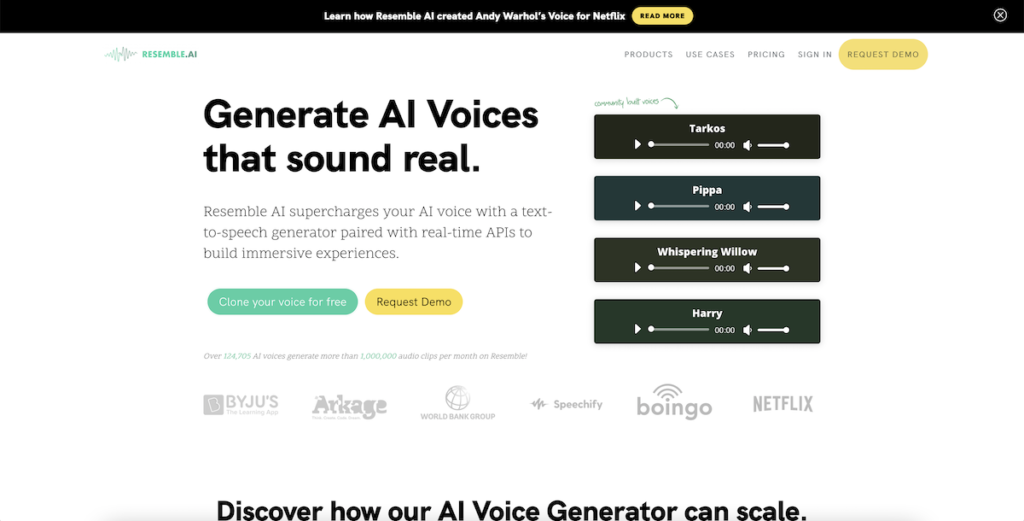
I’ve reviewed plenty of text to speech software in this article. Resemble AI is another great tool. The main focus of Resemble AI is on cloning your voice and creating your own text to speech skin based on your own personality.
Key Features:
You can use Resemble AI for several things.
Want to create custom brand voices for Alexa and Google Assistant? You can do that with Resemble AI. You can also create your own AI voice for other uses.
All you have to do is provide 50 sample recordings of your voice and Resemble AI will learn from them and create a synthetic voice that you can use for advertisements, call centres, smart assistants and other use cases.
They also have a marketplace for voice actors and an API for developers.
Pricing:
They have a free plan for 2,000 characters, which is around 2 minutes of audio.
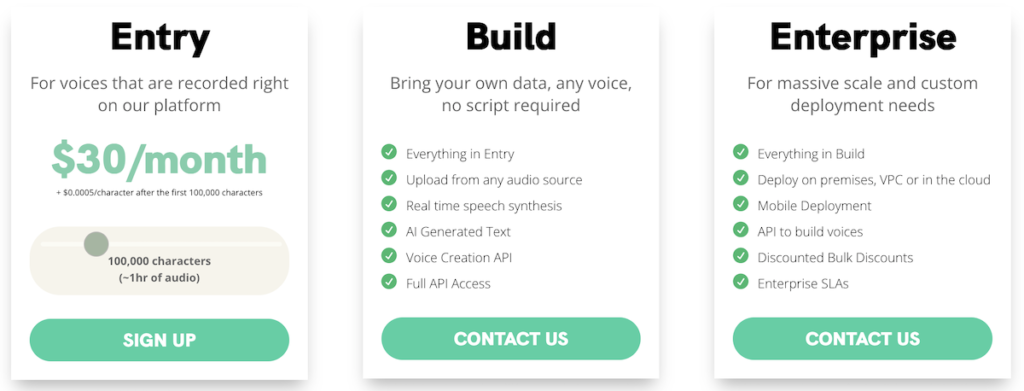
For $30 a month you can get 200,000 characters a month. Pricing options are scalable depending on your needs. For $480 you get 1,000,000 characters a month. If you want a custom solution, you can reach out to them and they’ll offer you a more custom-tailored solution.
What I Like/Dislike About Resemble AI:
Like:
- Free plan
- Focussed on voice cloning
- Can be used for smart assistants
Dislike:
- Some limitations
19. Capti Voice.
Good text to speech app for mobile devices.
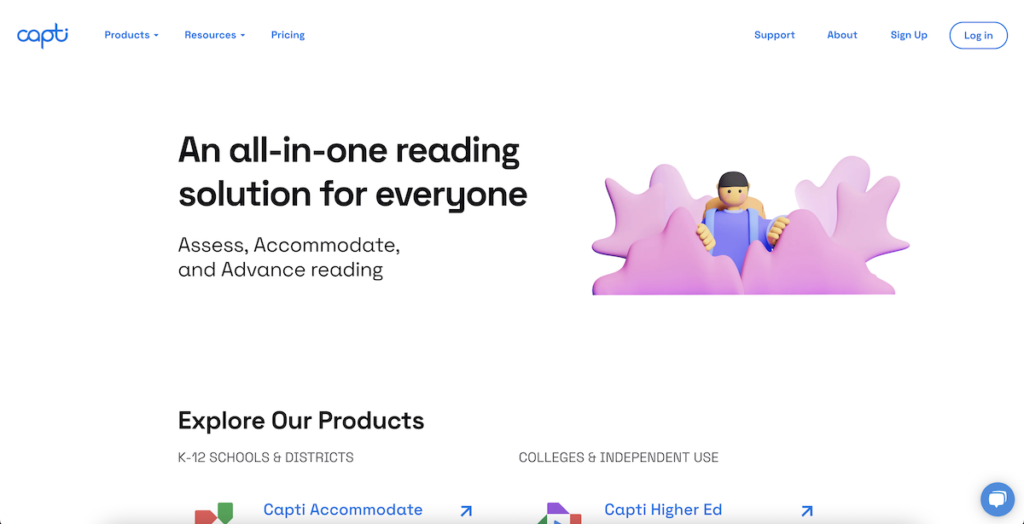
Capti Voice has a mobile app for iOS that allows you to turn text into speech. You can listen to articles, books and documents directly on your iPhone or iPad and easily add content from external sources.
Key Features:
Capti Voice is best for personal use.
You can listen to text-based content in a simple mobile app.
It’s a powerful app for anyone with learning or reading disabilities. If you need help turning text into audio that you can listen to, mostly for learning or entertainment purposes, Capti Voice is great.
They offer several products including Capti Personal, Capti Higher Ed, Capti Accommodate, Capti Assess and Capti Advance. The main use case is for improved learning rather than commercial purposes.
Pricing:
For personal use, Capti Voice offers in-app purchases including a paid subscription for $2.99 a month and premium voices for $1.99-$5.99 one-time.
What I Like/Dislike About CaptiReader:
Like:
- Cheap
- Great for mobile use
- Great for learning disabilities
Dislike:
- Not ideal for commercial use
Get started with Capti Voice.
20. Microsoft Azure.
Another top-notch text to speech engine.
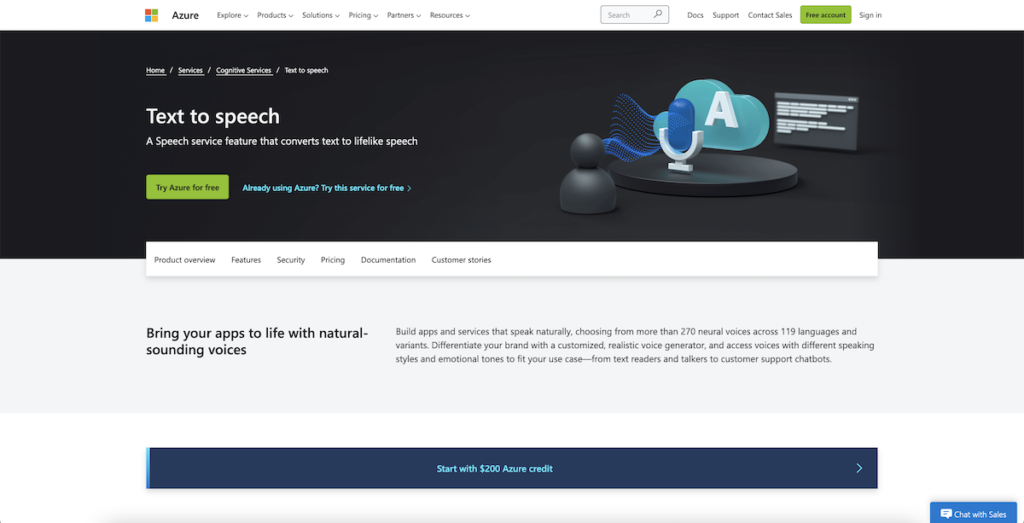
Just like Amazon and Google have their own text to speech engines, so does Microsoft. Microsoft Azue is another enterprise level AI solution for companies that need a scalable way to turn text into audio.
Key Features:
Microsoft Azure offers 270 neural voices in 119 languages.
You can access voices in different speaking styles as well as create your own brand voice.
Microsoft Azure pretty much does what Google and Amazon’s text to speech engines do as well. All of these tools are based on modern machine learning and come with natural sounding voices.
Pricing:
Azure offers a free plan with 5 audio hours per month. They also have a pay-as-you-go option starting at $1 per audio hour. And they have custom tiers starting at $0.80 per hour which are subject to approval.
What I Like/Dislike About Microsoft Azure:
Like:
- Cutting-edge artificial intelligence
- Huge and reputable company with track record
- Great for scalability
Dislike:
- Not so user-friendly
- Requires more technical skills
Get started with Microsoft Azure.
21. IBM Watson.
IBM’s enterprise level text to speech engine.
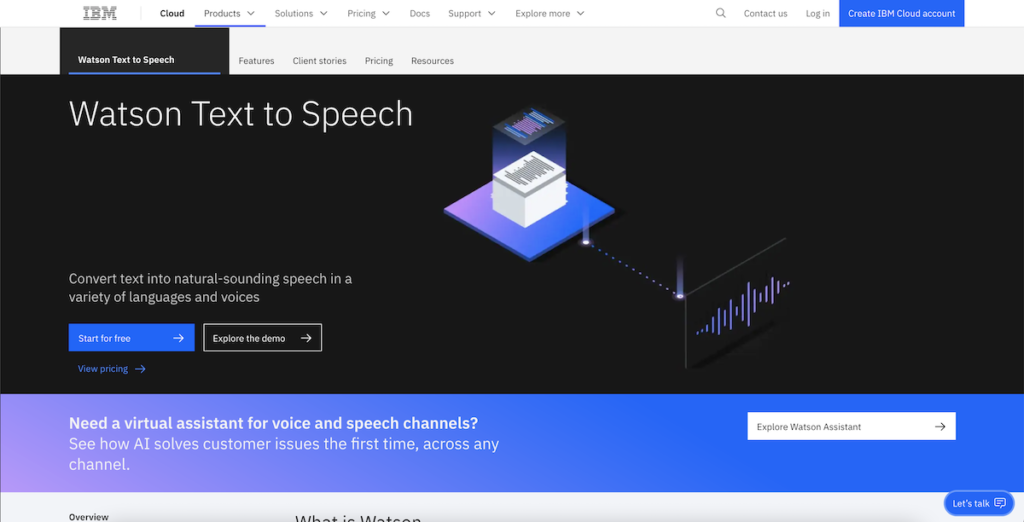
Since we’re at it, let’s include IBM’s Watson as well. IBM’s Watson is another cutting-edge AI engine that has the ability to turn text into speech in a cheap and scalable way for companies.
Key Features:
You can answer call centre queries with an artificially intelligent virtual assistant among other things.
Watson allows you to do more than merely turn text to speech. You can create an entire artificially intelligent assistant for your business, to answer phones, assist customers and help drive engagement.
This is why Watson’s text to speech functionality, although extremely sophisticated and modern, is best used by large enterprises. It’s not very user friendly and requires technical skills to implement. It’s not really suited for the average end user but rather for complex company needs.
Pricing:
They have a free tier.
Paid tiers start at $0.02 per thousand characters.
What I Like/Dislike About IBM Watson:
Like:
- Cutting-edge artificial intelligence
- Huge and reputable company with track record
- Great for scalability
Dislike:
- Not so user-friendly
- Requires more technical skills
22. NextUp.
Powerful text to speech software for Windows.
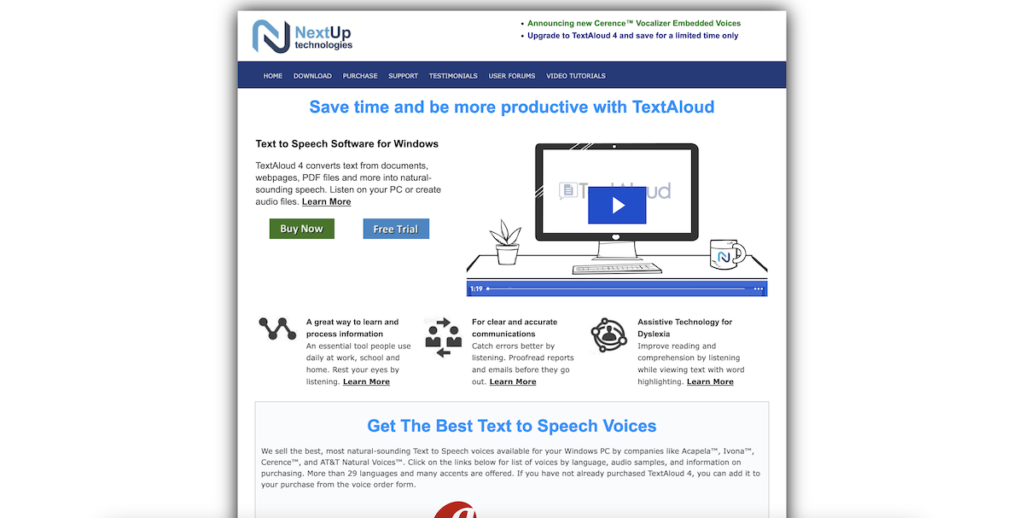
Next Up offers a product called TextAloud which allows you to turn documents, webpages, PDFs and other files into natural sounding speech. It’s best suited for personal use and people with learning or reading disabilities.
Key Features:
TextAloud is a Windows program. You have to purchase the software and then download it on your computer. From there, it’ll help you turn webpages, documents and other forms of written text into audio.
It can also be used for enhanced proof-reading but its most obvious use case is as an assistive technology and learning enhancement tool.
Pricing:
TextAloud costs $34.95 one-time with the ability to add some upgrades to the cart.
What I Like/Dislike About NextUp:
Like:
- Powerful for dyslexia
- Enhanced learning and assistance
- One-time payment only
Dislike:
- Not suited for commercial uses
Get started with NextUp.
What is Text to Speech Software?
Text to speech software allows you to turn written text into speech. Or in other words, it’s a piece of software that converts writing into audio.
There are several use cases for text to speech software.
The most obvious and original use case is to provide assistance for dyslexia, reading and learning disabilities. It can also be used as an assistive technology and learning enhancement tool in general.
Schools might use it and proofreaders can identify mistakes more easily among other things.
For content creators, bloggers, podcasters and website owners text to speech software can be used to turn written content into audio files. Bloggers can turn their blog posts into podcast episodes automatically, without having to record any audio themselves.
The can just feed the blog post into a text to speech software and end up with an audio recording of the article.
The audio can be embedded along with the article so people who prefer listening to the article can do that directly from within the article.
You can also turn written content into YouTube videos very easily without requiring your own voice.
Who Uses Text To Speech Software
Text to speech software can act as a powerful anonymization tool.
This is why the hacker group Anonymous famously uses text to speech software to create a robotic sounding voice for their videos and public announcements.
Apart from bloggers, other websites can make use of text to speech tools as well. For example, dictionary sites might want to have an option to read out loud a certain word.
Instead of having a voice talent record hundreds of thousands of words in a studio, modern text to speech software can do all of that automatically.
Finally, large companies and enterprises might want to use text to speech functionality in a variety of ways.
Wrap Up
Of all the 22 text to speech software I compared, ranked and reviewed, Play.ht is my #1 pick.
It’s best for most use cases.
It has reasonable pricing and comes with a lot of the most exciting features that I personally look for in a text to speech software. While some other tools have similar functionality, they are often too restrictive, sound overly robotic or lack certain features.
Play.ht has the largest selection of voices and languages and the ability to fine-tune voices with a pronunciation and phonetics library.
For most individuals, content creators and small businesses, Play.ht is the most user-friendly tool with the most functions and least limitations.
If you’re mostly looking to use text to speech as learning enhancement or because you have a disability, you might want to look into NaturalReader, ReadSpeaker and Capti Voice.
And if you’re a large corporation looking for a scalable cloud-based solution, Google, Microsoft Azure, Amazon Polly or IBM Watson might be interesting for you.
